The blanket made of plush yarn is very soft to the touch. The material is practically not deformed, no creases appear on it after folding. The composition may include different color finishes, so the assortment remains quite large.
The yarn is suitable for crocheting, knitting and even finger knitting. Solid colors are suitable for small sizes of fabric. Pastel shades with melange options of smooth transition will appeal to those who are going to knit large items. There are many knitting patterns, but it is important to consider the type of yarn, knitting method and thickness of the blanket.
Necessary tools and materials
To select the type of yarn, tools and consumables, you need to decide on the pattern, size and the desired pattern. Plain blankets look great when used in voluminous compositions, while multi-colored ones look great due to wave or zigzag patterns.
The yarn for this fabric is considered hypoallergenic and contains synthetic micropolyester plush.

A blanket made of plush yarn crocheted (the pattern for crocheting and knitting is presented in the master class) is easy to care for. The product does not require special components for cleaning. The material is resistant to fading in the sun, stretching and abrasion during long-term use.
Durable plush thread is suitable for creating simple volumetric patterns. Openwork elements are not suitable for knitting, arans and braids on the blanket will not be clearly visible due to the free weaving of the threads.
Plush may also contain additional components that are responsible for the color of the material:
- Acrylic – provides the plush yarn with low hygroscopicity. After washing, the product does not lose its previous dimensions. In combination with natural components, acrylic improves their natural properties.
- Silk pile - a base that can combine synthetic fibers. Sometimes the yarn is called "velour", "marshmallow" or "chenille".
- Viscose – created on the basis of cellulose, which has a high air permeability. The material does not accumulate static electricity and can be used as the only element in the yarn, as well as in combination with mixed threads. Washing should be delicate.
- Cotton It is considered a durable material, resistant to tearing and abrasion. The only drawback is the low elasticity of the threads.
It is also worth paying attention to the thickness and stiffness of the yarn, which will determine the softness and tenderness of the blanket:
| Purpose | Universal | Lightweight yarn |
| Heavy | Decorative yarn | |
| Fat | For floor coverings | |
| Children's | They have a hypoallergenic composition and are thin in structure. | |
| Seasonality | Summer | Blended and cotton |
| Winter | Medium hard wool, plush, mixed materials | |
| Autumn | Fine wool | |
| Drawing | Openwork | Thin threads without fluff or with a small amount. |
| Simple | Plush with loops and thick threads | |
| Manufacturing | Fast | A fluffy giant yarn with a simple pattern will take several hours up to 1-2 days. |
| Long lasting | Complex designs will take more time as they are made from thin threads. | |
| Characteristics | Plush | Suitable for children |
| Cotton | For lace blankets | |
| Merino | Soft wool | |
| Sheepskin | For volumetric drawings |
Mercerized cotton material is considered to be hard and is not suitable for fluffy items, children, or people prone to allergic reactions.
A blanket made of plush yarn crocheted (the diagram is provided for reference) will require a careful selection of tools. can be made using hook No. 4-6, knitting needles No. 5-5.5 or by hand.

It is worth considering that large bedspreads need to be knitted with circular needles, as the loops may fall off, or you will have to hold them with your fingers, which is inconvenient while working. You may also need a fishing line - 0.5 m is enough.
The yarn should fit completely into the eye of the hook, fit there completely. Large patterns are obtained with hook No. 8, the previous sizes are suitable for those who want to knit a small baby blanket.
Schemes with description of works for beginners
Learning to read diagrams is not difficult, you just need to know the basic symbols used in the drawing.
| Crochet | |
| Designation | Transcript |
| VP | Air loop |
| SBN | Single crochet |
| C1H | Column with 1 yarn over |
| C2H | Double crochet stitch |
| C3H | Column with 3 yarn overs |
| C4H | Column with 4 yarns |
| Knitting | |
| P. | Loop |
| R. | Row |
| Persons. | Face loop |
| Out. | Purl stitch |
| Aux. | Auxiliary loop |
| Corresponds. | Corresponding |
| Track. | Next |
In addition to conventional symbols, figurative symbols may be used in drawings. As a rule, diagrams are always accompanied by a decoding in the form of accompanying information.
In Japanese knitting technique there is a separate scale of abbreviations, so it is difficult to learn all the variants of geometric figures.
It will also be useful for beginners to calculate in advance the yarn consumption for making a blanket of different sizes:
| Yarn | Volume – width, length of the blanket (cm) | Consumption (skeins) |
| Alize Puffy | 80*80 100*100 150*150 | 5 7 12 |
| Alize Puffy More | 80*80
100*100 100*150 150*150 150*200 200*200 200*250 | 6 8 13 18 24 32 40 |
You can calculate the consumption yourself based on the initial data and characteristics regarding the footage, weight of the finished product, yarn density and fabric size.
To do this, you need to do the following:
- The test sample needs to be unraveled and the length of the threads measured.
- The resulting quantity must be multiplied by the length of the finished product.
- The sample must be weighed and multiplied by the first number obtained.
- The length and weight in skeins must be divided by the data specified in the accompanying documentation or label. This way you can find out the required number of skeins for one product.
After calculating the thread consumption, you can begin to select the knitting pattern and design.
Crochet
A blanket made of plush yarn crochet (the diagram and decoding are described in this master class) can be knitted in a simple way using a simple pattern. Regular loops are used to collect the material with a crochet hook, the air chain should be equal to the width of the blanket. According to the diagram, only the height should be knitted.
Recommended rapports:
- Single crochet; multiple colors can be added.
- Zigzag or wave is done by alternating different shades. You can do without finishing the edges.
- Birds or jackdaws are a dense type of fabric that will be less prone to shedding, tighter and without large holes.
- Granny square is a simple way to knit 20-26 stitches by joining them together. This pattern is suitable for those who want a lightweight blanket, but it will not be too warm.
- Cones are a decorative element that can add and retain warmth in the canvas. The pattern is not transparent, dense, suitable for children's canvas.
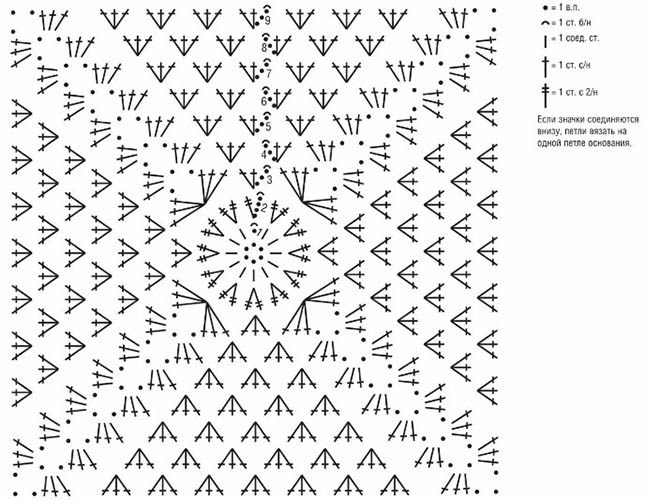
The master class will use hook No. 6, 13 skeins of Alize Puffy More threads:
- Cast on a chain of air loops equal to the height of the blanket. For best results, start with the long side. In standard patterns, you can start from the bottom along the width of the product.
- After finishing knitting the first row, you need to knit the lifting loops. 3-4 VP is enough.
- The second row contains C1H - equal to the number of air loops in the first row.
- In the 3rd row you need to knit 3-4 VP for lifting.
- Then continue the 3rd row with C1H.
- Then you need to repeat the rows with the insertion of rapports - loops for symmetrical raising of rows on each side of the fabric through 1P.
The last loops are knitted completely and closed with a single crochet. The knot can be hidden inside with a needle and thread.
To knit the “cones” pattern, you need to take 6 skeins of Alize Puffy More yarn for a blanket 80*80 cm:
- Cast on a chain stitch of length equal to the width of the garment.
- In the 6th loop you need to make a bump - 3 incomplete sc.
- The hook with 3 loops must be passed through the thread.
- To make the cone larger, the number of columns can be increased.
- For the cone you will need 3 to 5 partial sc.
- Next, knit 1-2 VP. The pattern should be repeated until the end of the row.
- The next cone should be located above the previous one, knitting 2-3 VP.
- You need to finish the row in the same way, skipping 2-3 VP.
- Repeat rows alternating until desired height is achieved.
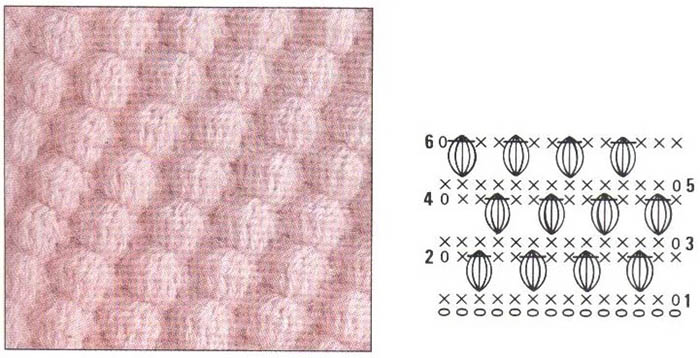
To arrange the cones in a checkerboard pattern, you need to tie incomplete SC between the cones of the previous row. To do this, you can tie SC between the cones so that the next pattern fits between the cones.
A blanket made of plush yarn crocheted (the knitting pattern is suitable for beginners) with a "cones" pattern can turn out more voluminous. Incomplete columns give the fabric additional height and less elasticity in the folding of the material.
To make smaller cones, you can knit a smaller number of loops, passing the thread with a hook through 1-2 loops. This blanket is suitable for babies; it will warm the child during sleep.
With knitting needles
Knitting is suitable for experienced craftswomen who know how to hold loops, know how to make a pattern and keep the fabric from distorting and stretching. In any case, it is better to choose simple patterns and designs so that knitting takes less time.
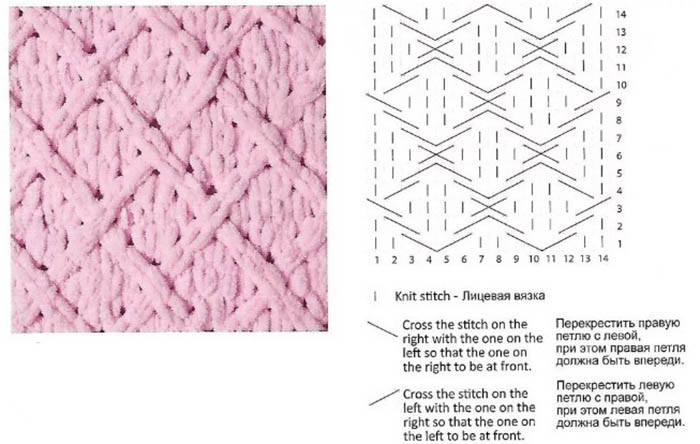
The rapport usually consists of front and back loops. All patterns for plush threads should be checked in advance by knitting a sample of the product of a smaller volume.
Rapports for plush skeins for knitting with knitting needles can be different:
- Shawl – front loops are on the front side, back loops are only on the back side.
- Hosiery – all loops are knit.
- Rice or grain – in the pearl knitting technique, there is an alternation of purl and front loops.
- In a checkerboard pattern Only squares from the basic loops are used. The sizes of the patterns can be made large or small.
- Waffle pattern is performed not only by alternation, but also by a set of additional and auxiliary loops with false knits. This is a complex pattern, which is best performed by experienced craftswomen.
To knit a simple pattern, it is better to choose a garter stitch pattern.
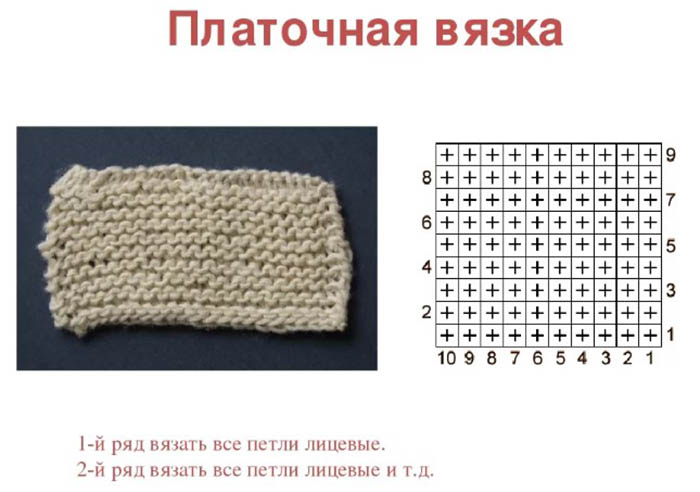
It is suitable for rectangular blankets.
- The loops must be calculated according to the pattern, which should be knitted in advance.
- First, you need to cast on and knit as many loops as required to achieve the desired height of the product.
- In the 1st row you need to knit a purl stitch.
- The second row contains only knit stitches. Knit stitches are worked under the drawstring between the loops, but the loops themselves must be removed and not knitted in the usual way.
- In the 3rd row you need to knit 2 purl sts together.
- Starting from the second row, you need to repeat all the previous rows.
- When you reach the desired height in the last row, remove the 1st loop without knitting.
The last loops in the rows always remain purl, they must be knitted. To obtain large loops, you can use light yarn. Do not choose a larger hook if you want to achieve a loose effect. To do this, you need to choose yarn of the right density.
With hands
For hand knitting, you need to accurately calculate the number of skeins needed to create a blanket. One skein can contain 100 g of yarn, where less than 10 m of thread. Hand knitting without tools may seem more difficult, however, when making a pattern, you should take into account the expectations of the finished result. It may not seem so attractive, crooked or skewed in places.
The work will use not only knit and purl stitches, but also adding/reducing stitches:
- To add loops, you need to pull 2 loops from the skein through one in the fabric.
- To decrease, you will need to pull the loop through 2 loops at once in the finished product.
- The purl stitch is knitted by hand by threading the loop from front to top and back.
- The knit stitch is knitted by pulling the yarn through the back and pulling the loop up and to the front.
- To offset, take the right loop and place it over the left so that the loop from the skein can be pulled through the front loop and then through the back loop.
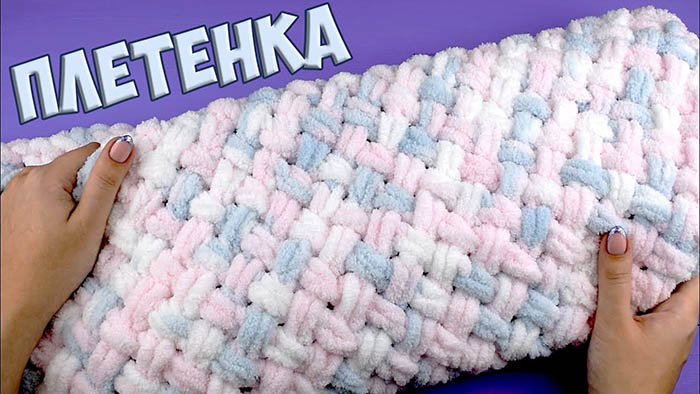
Due to the thickness of the loops and the hand knitting method, the process can take several hours without taking breaks into account:
- You need to cast on at least 50 stitches from the skein. A larger number is suitable for larger blankets.
- The simplest and most convenient way would be the "braid" knitting pattern. The loops need to be laid out on a flat surface.
- The front loop should be twisted to one side.
- The right loop needs to be passed through the 51st st.
- 49 sts need to be turned to the left and knitted through the 52nd using the thread from the skein.
- The remaining loops need to be turned to the left, starting with the first loop.
- All rows must be repeated according to the principle described in point No. 6.
- The last row should be knitted like this: the 2nd st. should be turned to the left and threaded into the right one, after which the 3rd should be threaded through the 2nd.
A blanket made of plush yarn should not be twisted or turned over. Rows should be knitted from the left and in the opposite direction. Crocheting and knitting are more convenient due to the ability to control these processes.
The more complex the pattern for hand work, the more time it will take to distribute the loops, and not the actual process of casting on and knitting them.
Secrets for Beginners
Plush yarn is considered an ideal material for knitting large blankets.
However, there are some nuances in manual work that you need to know:
- Crossed loops allow the fabric to be denser. Due to the width of the hands and fingers, some patterns are slanted and loose. To achieve this, each loop in each row must be turned over.
- A hand-knitted blanket must be finished on all edges. To do this, use a piping without loops.
- Using different shades of yarn in the hand method can result in slanted patterns. To avoid this, twist all knit stitches twice before knitting.
- Beginners are advised to choose the thickest type of yarn. It is more convenient to work with even simple patterns.
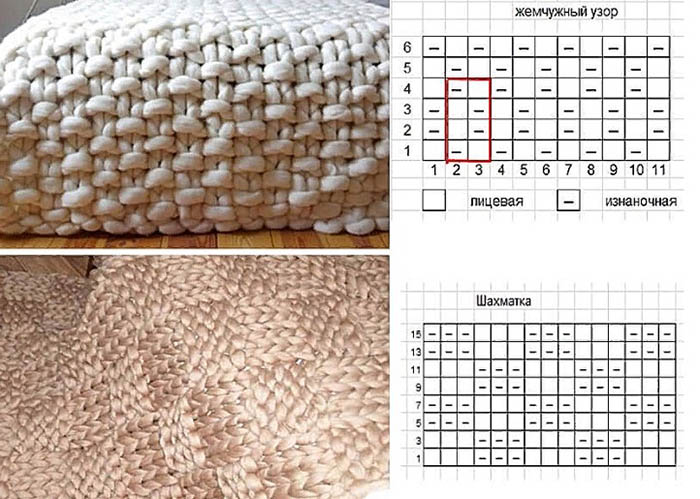
When knitting or crocheting, it is also important to follow all the instructions for working with threads and to adhere to the parameters of the rapports:
- It is not recommended to use thick knitting needles for thick yarn. It is better to choose the manual method of creating a blanket.
- Knitting needles are only suitable for those who know how to work with them and use the tool often.
- If it is difficult to calculate the thread consumption, you can contact the store. There are specialists there who will help you choose the right number of skeins taking into account the density and size of the product.
- Thick threads are able not only to retain heat, but also to form a dense pattern. To achieve the desired pattern, it is recommended to always knit a sample. It also helps in calculating the thread consumption.
- The larger the blanket, the more carefully you need to think through the pattern. A wide blanket will require more thread, taking into account the patterns. Since you will need more skeins just for zigzags or cones, the consumption can be doubled.
- Alize Puffy yarn is considered to be of the highest quality. It can be unraveled and knitted into new items without losing the quality of the thread.
- The products do not fade or lose shape. Before using the blanket, you can wash it by hand or in a washing machine to get a fresh, like a newly purchased blanket.
- You can fluff up the blanket after washing with a fine-toothed comb. An alternative would be a clothes brush. The long pile will look like new.
- Lanolin prevents the pile from rolling. It should be used together with a gel detergent.
- If the blanket is electrified, foil placed in the drum of the washing machine will help neutralize static electricity. It is advisable to put a rubber mat on the floor or make sure that the socket for the machine is grounded.
- If you don't have circular knitting needles, you can attach a fishing line to regular knitting needles.
A blanket knitted from plush yarn will serve not only as a blanket or bedspread. It can be used in a child's bed, as an interior item, and also as a gift for newlyweds. Simple designs are created with a crochet hook, and complex ones with knitting needles.
Patterns using simple schemes can be made by hand. The remains of plush can be used to create children's toys or floor mats.
Video about knitting a blanket
Master class: how to knit a blanket with a braid pattern, how to make a binding:
